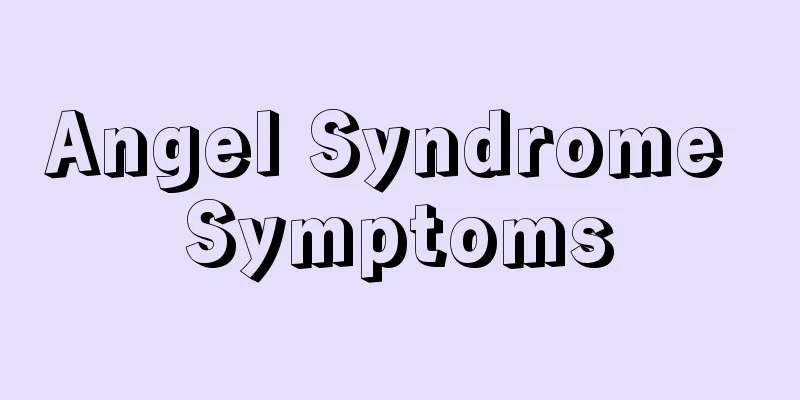Angel Syndrome Symptoms

|
Angelman syndrome is a neurological disease, which is characterized by the patient's slow reaction and development much slower than normal people. Patients with Angelman syndrome are generally children, which greatly hinders their growth and development. Some of them may even cause children to develop differently from normal people, which is often called malformation. So, what are the symptoms of Angelman syndrome? Angel syndrome: also known as happy puppet syndrome, its English name is “Angelman syndrome”. First reported by British pediatrician Angelman, it is a group of neurodevelopmental diseases caused by defective expression of the maternal UBE3A gene affecting 15q11-13. Literature reports that its incidence rate is approximately 1/15,000, making it a rare disease. Typical clinical manifestations of Angelman syndrome include: Typical findings in almost all Angel Children: 1) Severe developmental delay, usually with more pronounced intellectual disability 2) Movement and balance disorders, usually manifested as gait ataxia, stiff steps, or tremors in the limbs. Sometimes it may also manifest as twisting limbs, clumsiness 3) Unique behaviors, including laughing, laughing at inappropriate times, always appearing happy, easily excited and agitated (such as clapping), large movements, hyperactivity, and short attention span 4) Language development disorder, with little or no use of words, or only some repetitive or receptive language Symptoms present in approximately 80% of Angel Children 1) The head circumference is generally normal at birth, but it increases slowly and often manifests as a small head (less than 2 standard deviations of normal) after 2 years of age. 2) Epileptic seizures, which usually begin before age 3 and become less severe with age, but can persist into adulthood. 3) Abnormal EEG, which often shows special brain wave patterns, but the degree of EEG abnormality is not completely parallel to epileptic seizures. About 20%-80% of Angel children may have symptoms such as: 1) The occipital bone (back of the head) is flat or concave; 2) They like to stick out their tongues; some have sucking disorders and often drool; 3) Difficulty feeding during infancy; some have hypotonia during infancy. 4) Protruding jaw, large mouth, widely spaced teeth, less skin pigmentation, lighter hair and pupil color (compared to other people in his family) 5) Excessive chewing, making funny faces, and other seemingly funny behaviors 6) Strabismus 7) When walking, likes to lift arms; has foot valgus, wide gait 8) is sensitive to heat 9) Abnormal sleep cycle, which may be manifested as less need for sleep 10) Likes water and things with many wrinkles, such as paper and plastic bags 11) Eating accompanied by abnormal behavior 12) Obesity in old age 13) Scoliosis 14) Constipation |
<<: What should I do if my hands are soaked in pepper water?
>>: What are the symptoms of myocardial infarction_Symptoms of myocardial infarction
Recommend
Feeling of heaviness in the abdomen
Pregnant women always experience various discomfo...
What causes anal swelling?
There are many reasons for anal swelling. It may ...
The main manifestations of early cervical cancer will help you understand the three manifestations of cervical cancer
The main symptoms of early cervical cancer are va...
What is human bioelectric meridian therapy
Human bioelectric meridian therapy has been welco...
What is the function of Nasatong
Bisatong is a commonly used drug for the clinical...
The most effective treatment for breast cancer 4 treatments for breast cancer
Breast cancer is a malignant tumor with a high in...
Which is better, a glass cup or a ceramic cup
Glass cups and ceramic cups are relatively common...
How to effectively and completely cure small cell lung cancer
How can small cell lung cancer be effectively and...
Lumbar disc herniation treated with acupuncture, Chinese medicine treatment is effective
The most common cause of low back and leg pain is...
What to do if you are woken up by mosquito bites in the middle of the night
In summer, mosquitoes are always rampant in swarm...
Does insomnia mean neurasthenia?
Insomnia is a common phenomenon. Being worried or...
To prevent gastric cancer, you need to change your diet structure
The incidence of gastric cancer is very high, and...
Is it okay to soak your feet every morning and evening?
Now the temperature is slowly starting to drop, o...
Does hamartoma require long-term medication?
Do people with hamartomas need long-term medicati...
People who are not suitable for drinking Imperatae and Bamboo Sugarcane Water
In summer, everyone can drink more herbal tea to ...









